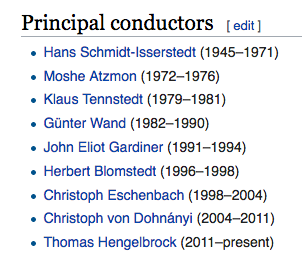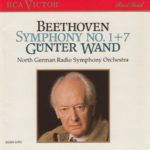 This morning (Day 17 of my 18-day exploration of Beethoven’s First), under storm-threatening skies, I sit once again at Panera Restaurant – a place to which I keep swearing I’ll never return, although the reasons why seem to escape me at the moment.
This morning (Day 17 of my 18-day exploration of Beethoven’s First), under storm-threatening skies, I sit once again at Panera Restaurant – a place to which I keep swearing I’ll never return, although the reasons why seem to escape me at the moment.
Sloppy service, so-so food, and a Light Roast coffee pot that seems perpetually empty are likely candidates. Yet, Panera is almost the only game in town at 6am when I like to get to work on these blog projects. Plus, the Asiago bagel (toasted until very dark) with plain cream cheese and – when I can get it – Light Roast coffee are an inexpensive ($5.60) and tasty way to pass a couple of hours before I head to the office.

So here I am.
So too is German conductor Gunter Wand (1912-2002) and the North German Radio Symphony Orchestra playing Beethoven’s Symphony No. 1 in C Major.
From his bio on Wikipedia,
Günter Wand (January 7, 1912, in Elberfeld, Germany – February 14, 2002, in Ulmiz near Bern, Switzerland) was a German orchestra conductor and composer. Wand studied in Wuppertal, Allenstein and Detmold. At the Cologne conservatory, he was a composition student with Philipp Jarnach and a piano student with Paul Baumgartner. He was a conducting pupil of Franz von Hoesslin in Munich, but was otherwise largely self-taught as a conductor. During his 65-year-long career as a conductor, he was honoured with many significant awards, including the German Record Award and the internationally important Diapason d’Or.
Artistic style
As a conductor, Wand was a deep believer in the originality of music, aiming to perform works exactly as annotated. His art was marked by straightforward adherence to the score.
As still a young conductor, a journalist asked him how he’d consider interpreting Beethoven’s ninth symphony, more like Arturo Toscanini or rather like Wilhelm Furtwängler. Wand answered laconically: “like Beethoven”.
The orchestra is one I have not yet heard in the 17 days of my Beethoven project. From its bio on Wikipedia I learned,
The NDR Elbphilharmonie Orchester (NDR Elbphilharmonie Orchestra) is a German radio orchestra based in Hamburg. Affiliated with the Norddeutscher Rundfunk (NDR; North German Broadcasting), the orchestra is based at the Elbphilharmonie in Hamburg, Germany. Earlier the ensemble was called the NDR Symphony Orchestra (German: Sinfonieorchester des Norddeutschen Rundfunks), and was also known in English as the North German Radio Symphony Orchestra.
British occupation authorities founded the orchestra after World War II as part of Radio Hamburg (NWDR), which was the only radio station in what would become West Germany not destroyed during the war. The first musicians came mostly from the ranks of the old Nazi-controlled Großes Rundfunkorchester des Reichssenders Hamburg. Hans Schmidt-Isserstedt, who was living near Hamburg, was given the task of assembling the members, something he accomplished over a period of six months. Schmidt-Isserstedt conducted the orchestra’s first concert in November 1945, with Yehudi Menuhin as soloist. Schmidt-Isserstedt served as the first chief conductor of the orchestra, through 1971.
I also learned that its list of principle conductors includes a couple of names of which I am familiar.

In addition to the aforementioned Maestro Wand, I recognize the names Klaus Tennstedt and Herbert Blombstedt.
Looking outside I see the tell-tale signs of clouds wanting to rain, including a dappled sidewalk where drops have already fallen. I see trees bending in the wind. But I’m not seeing any rain falling from the sky. Not good. It’s been unusually dry and hot here this summer. We need all the rain we can get.
Inside here at Panera, the supply of Light Roast coffee surprisingly plentiful this morning, I am listening to something that grabbed me by the lapels from the first notes of Movement I – which is surprising because in my Bruckner projects (144 Days With Bruckner And Me 63 more Days With Bruckner And Me), and from 2016-2017, Gunter Wand bored me to tears. I chose him for my Beethoven project because he is a conductor of high regard and I wanted to see what he could do with Beethoven. Maybe Bruckner wasn’t his bag.
But Beethoven certainly is.
 Beethoven wrote his symphonies in four parts (except for the Sixth, which is in five). The time breakdown of this one (Symphony No. 1 in C Major), from this particular conductor (Wand, at age 76) and this particular orchestra (North German Radio Symphony Orchestra), at this particular time in history (October 10-15, 1988) on this particular record label (RCA Victor Red Seal, now owned by Sony) is as follows:
Beethoven wrote his symphonies in four parts (except for the Sixth, which is in five). The time breakdown of this one (Symphony No. 1 in C Major), from this particular conductor (Wand, at age 76) and this particular orchestra (North German Radio Symphony Orchestra), at this particular time in history (October 10-15, 1988) on this particular record label (RCA Victor Red Seal, now owned by Sony) is as follows:
I. Adagio molto………………………………………………………………………………..8:42
II. Andante cantabile con moto………………………………………………………8:29
III. Menuetto. Allegro molto e vivace………………………………………………3:29
IV. Adagio – Allegro molto e vivace…………………………………………………5:50
Total running time: 26:50
My Rating:
Recording quality: 4 (slight tape hiss and some ambient sounds)
Overall musicianship: 5
CD liner notes: 3 (a booklet in each CD jewel case; however, the essays on Symphonies 1 and 7 are brief and not very informative – almost more philosophical than informative. In addition, the bulk of the text is in German, although the essays are also translated into English and French )
How does this make me feel: 5
It must be the strings, how the strings are recorded. I appear to shout “Huzzah!” when, from the first few notes, the sound is expansive with very clear strings and a powerful bottom end for punch.
Whatever the reason – and I have been pondering it for years – this recording pushed all of my buttons. Movement I (Adagio Molto) was sprightly, powerful, and even somewhat playful. My face was in a smile and my head was bobbing to the bouncy beat.
And the Finale (my favorite of Symphony I) was precisely what I like to hear in Classical music: lots of textures, varying rhythms, and color. I can’t help but feel happy as a lark listening to this piece of music.
“Huzzah!” I say.
“Huzzah!” to Maestro Wand and the musicians of the NDR.
This was a pleasurable experience.
Thanks to some chap with Chinese characters for a name on YouTube, this is precisely the same symphony to which I listened this morning. Give it a listen yourself. See if it doesn’t make you shout “Huzzah!” too.
